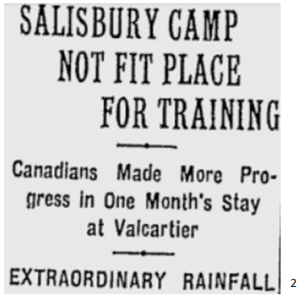Monday, January 4, 1915
In Camp, Lark Hill, Salisbury Plains
The Battalion War Diarist wrote for this day: “Duty Battn. No parades. All men on fatigues.” [1]
 THIS DAY IN RMR HISTORY: “Salisbury Plain, Jan. 4. – A welcome change is in sight for the whole of the Canadian artillery, cavalry and ammunition columns, numbering in all between 5,000 and 6,000 men who are to be billeted in the homes in the villages around the Plain. The change has come none too soon. The sick list in camp has reached proportions which are really disconcerting, causing a good deal of anxiety to the medical men, to say nothing of the discomfort of those who are brought low by violent coughs, colds, sore throats and other ailments due to the atrociously wet weather that has afflicted England ever since the Canadians have been here.
THIS DAY IN RMR HISTORY: “Salisbury Plain, Jan. 4. – A welcome change is in sight for the whole of the Canadian artillery, cavalry and ammunition columns, numbering in all between 5,000 and 6,000 men who are to be billeted in the homes in the villages around the Plain. The change has come none too soon. The sick list in camp has reached proportions which are really disconcerting, causing a good deal of anxiety to the medical men, to say nothing of the discomfort of those who are brought low by violent coughs, colds, sore throats and other ailments due to the atrociously wet weather that has afflicted England ever since the Canadians have been here.
According to the British Rainfall Association’s records, the rainfall of 6.34 inches last month was three times as much as usual in this month, and one has to go back 57 years to find anything to equal it. Indeed, there are only three other months for which a higher figure can be found – June 1878, with 6.71 inches; August 1878, 6.72 inches; and June 1903, 6.47 inches. The average rainfall for December is 2.13 inches. With regard to the duration of the rain, the total hours in which rain fell during the month numbered 107.5 hours, the greatest ever recorded in the 34 years for which continuous records have been kept. The camps and camp roads almost beggar description, the seas of mud and water making anything like serious effective drill a sheer impossibility. Canadians at home who saw Valcartier Plain with its light porous soil can form no conception of the morasses through which their men have marched and counter marched.
It would not be surprising if those who live at home remote from this land of training camps – for Britain today has become one vast school in which two millions of men are training for war – got impatient at the delay and the dull reports of dreary, ineffectual days of preparation here, to say nothing of the miseries of the men in camp. Whether all has been done that could be done to meet the needs of the situation is open to doubt. Britain finds herself with her hands full in every quarter of the globe, and right nobly she has set to work. Obviously,in such circumstances, responsibility has rested upon those in local commands, and some of us think that earlier efforts should have been made to billet the Canadian troops. In a word, that steps should have been taken to conserve their health and stamina, if nothing could be done to increase their military efficiency, for if possible the one is more important than the other.
Whether our troops will really be fit to go to the front this month, as is generally supposed, is open to doubt. One officer who went through the South African War declares that more progress was made in the month at Valcartier than in three months here. At present all the troops have not received complete equipment. Some 15,000 pairs of British-made boots have just been procured, for many of the soldiers have not had dry feet since they came here. The only footwear that efficiently resists weather conditions on Salisbury Plain are rubber Wellingtons, which cost $5. per pair.” [3]
[1] War Diary, 14th Canadian Battalion, The Royal Montreal Regiment, Jan 4, 1915. Library and Archives Canada, Ottawa, http://data2.collectionscanada.ca/e/e044/e001089686.jpg
[2] “Salisbury Camp Not Fit Place For Training,” The Gazette’s Correspondent, The Gazette, Montreal, Quebec, Monday, January 18, 1915, pg. 11, col. 1
[3] Ibid

